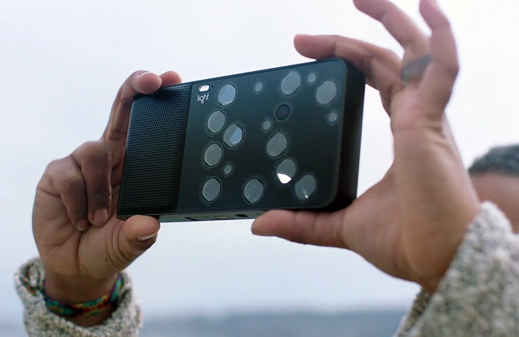A High-End Camera in a Small Package
A photography startup is building a camera that shoves the picture-taking power of a big DSLR camera and several detachable lenses into a gadget roughly the size of a paperback.

Light, based in Palo Alto, California, plans to start taking preorders for its L16 camera on Wednesday for $1,699, though some would-be customers may pause when they learn it won’t ship to them until late next summer.
The rectangular black camera can capture images of up to 52 megapixels. Unlike most cameras, which use just one lens and image sensor, the L16 will squeeze in 16 camera modules with three different focal lengths—five 35-millimeter ones, five 70-millimeter ones, and six 150-millimeter ones. Each of the camera modules will have a 13-megapixel image sensor. The cameras will simultaneously snap their own shots from different perspectives when you take a picture, and software will combine them automatically into one image that mimics what you’d get from a DSLR camera with a large lens attached to it.
“We don’t think that on day one everybody drops their DSLR and buys one of these, but we think there’s a great population of people that will appreciate the size, cost, and weight reduction,” says Light cofounder and CEO Dave Grannan. A high-end DSLR camera and equipment can cost thousands of dollars.
The Light Story from Light on Vimeo.
The company has been working on its technology since 2013. In April, Light said it would bring its first cameras, with 52-megapixel resolution, to smartphones next year through a deal with contract electronics manufacturer Foxconn, which also invested an undisclosed amount in the company (see “A Way to Get Much Higher-Resolution Selfies”). Light cofounder and CEO Dave Grannan says it still expects that to happen late next year.
In the meantime, Light is working on the L16, which has the same technology but in a stand-alone form. The camera relies on what’s known as folded optics: each camera module is placed on its side, and light comes in through an aperture, hits a mirror, and then travels down the barrel of the lens to an image sensor. Since the camera modules have different focal lengths, different ones will fire at once depending on how close you want to zoom in on a subject and how the mirrors inside the modules move to grab light.
During a recent meeting in San Francisco, Grannan showed me a model of the camera that wasn’t working at the moment, along with several photos that were taken with it to offer a sense of the detail it can capture.
In one image meant to compare the capabilities of the L16, an iPhone 6, and a Canon DSLR, the image focused on the crackly glaze of a blue-green vase and fabric of a chair in a hotel room. Up close, the crackles of the glaze and stitching of the chair were definitely crisper and showed more detail than they were in the images from the other two cameras.
The L16 will include a display (but no viewfinder) and a battery meant to last for about 400 shots. Grannan says the camera will use a modified version of Android as its operating system, and it will be able to connect to Wi-Fi networks for sharing photos. Some less-intense image editing will be possible on the camera itself—users may be able to correct color, for instance—and after taking photos users will be able to manipulate them on a computer to do things like change the depth of field.
Photography lovers may have a hard time adjusting to the L16’s form, which is radically different from the cameras and lenses they’ve used for years. Grannan thinks they will adapt, though he admits it could take a decade for high-end digital cameras to make the shift from bulky devices we have now.
Keep Reading
Most Popular
Large language models can do jaw-dropping things. But nobody knows exactly why.
And that's a problem. Figuring it out is one of the biggest scientific puzzles of our time and a crucial step towards controlling more powerful future models.
How scientists traced a mysterious covid case back to six toilets
When wastewater surveillance turns into a hunt for a single infected individual, the ethics get tricky.
The problem with plug-in hybrids? Their drivers.
Plug-in hybrids are often sold as a transition to EVs, but new data from Europe shows we’re still underestimating the emissions they produce.
Stay connected
Get the latest updates from
MIT Technology Review
Discover special offers, top stories, upcoming events, and more.